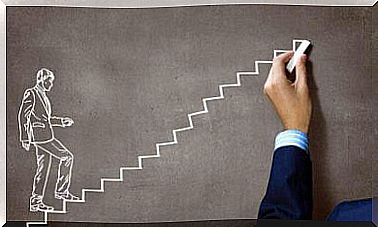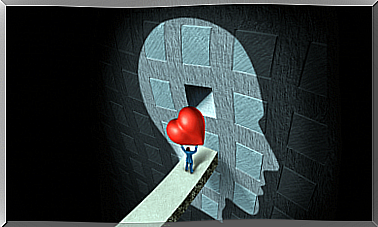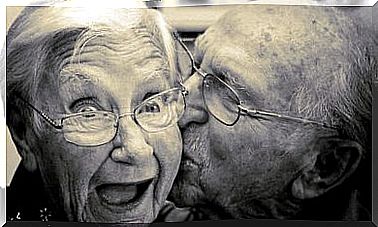Guilt, Shame And Pride, Or Self-conscious Emotions

In the field of psychology, self-conscious emotions are a category of emotions that involve evaluation relative to oneself. For example, feeling ashamed when giving your opinion, feeling guilty about what we have done one day or feeling proud of an achievement …
These are emotional states that have common characteristics. However, they also exhibit specific traits depending on how the behavior is assessed and how it is attributed. Let’s take a closer look.
In recent years, emotions have grown in importance. They are no longer the great forgotten ones, on the contrary. However, we still have a lot to discover about them.
There are indeed many studies today on basic emotions and emotional intelligence. However, the same is not true for these emotions, whose variability and complexity are greater. This is for example the case with self-conscious emotions.

Self-conscious emotions
First of all, interest in this type of emotion has recently increased and they are now the subject of theoretical models. Thus, according to various studies, self-conscious emotions share a number of common characteristics. These are emotions:
- Secondary: this means that they are the result of other deeper emotions
- Complex: they first require the development of certain cognitive abilities. For example, the notion or consciousness of self. That is, it is necessary that there is a difference between oneself and others for them to exist
- Social : they manifest themselves in an interpersonal context
- Morals: this type of emotion is the result of the internalization of values, norms and cultural criteria from which one establishes what is correct and what is not in terms of behavior. In addition, they act as fundamental motivators and controllers of moral conduct. For example in the same way as empathy
Thus, guilt and shame can inhibit behaviors considered immoral. Or to facilitate those cataloged as highly moral. Indeed, the fear of shame or guilt promotes socially desirable behavior. On the other hand, pride is associated with a good deed. It encourages the reproduction of similar actions in the future.
Another important fact mentioned by different authors to keep in mind is the following. Although these emotions are “self-conscious,” the self-report that precedes them does not have to be conscious or explicit.
The different aspects of guilt, shame and pride
Despite a number of common traits, self-conscious emotions also have some distinct aspects. Indeed, each of them arises from a particular event, relates to a particular subjective experience and involves a set of different behaviors.
Michael Lewis has developed a model that explains self-conscious emotions from two variables:
- Positive or negative assessment of one’s own behavior
- Internal attribution (global or specific) which is done on the behavior
According to the author, we rate our thoughts, feelings and actions as successes or failures. This assessment is carried out according to a series of rules, standards and objectives, both culturally and personally. Finally, we apply internal attributions to them. That is to say, we reflect on what they are due.
If we consider success or failure to be due to our ego as a whole, internal attribution is global. However, if we consider it to be due to a certain thought, action or feeling, it is specific. Finally, from there, one or the other of the emotions arises.
Moreover, this whole process depends on both cultural influences and personal variables. For this reason, the same action can be considered a failure by one person and a success by another. The same thing happens with attributions. Indeed, they can be global or specific depending on the person.
Now let’s explain the main characteristics of this type of emotion from Lewis’ perspective.
Guilt and Shame: Emotions with Negative Self-Ratings
When we feel ashamed, we negatively evaluate ourselves on a global level. We want to hide or disappear because we perceive that we have made a fool of ourselves. All we want is to get rid of this discomfort. In fact, we experience some mental confusion. Nevertheless, it is not that easy to get rid of this emotional state. Repairing certain actions is sometimes not enough. We therefore resort to mechanisms such as forgetting or reinterpreting what happened to get rid of this feeling.
On the other hand, guilt arises from a negative evaluation of oneself at a specific level. That is to say because of a concrete action. We feel guilty for something we have done, thought or felt, because we have done wrong. However, in this case, the action is not interrupted. So, guilt involves repairing this action to get rid of the associated emotional state. Finally, the process is accompanied by a reflection on how we are going to act in the future to avoid feeling this type of emotion.
Lewis considers guilt to be less destructive and more useful than shame because of the implication of corrective action.

Pride and pride: emotions with positive self-evaluations
Pride arises from a specific positive assessment of oneself. When we feel proud, we do it because we are satisfied with an action that is ours. Since this is a pleasant emotional state, it is very likely that we have a tendency to try to reproduce it again.
Michael Lewis, in his explanatory model on self-conscious emotions, also refers to pride, vanity or even excess as exaggerated pride. It is a personality disposition, rather than an emotional reaction. It is an emotion that is not lexicalized in English or in French. It stems from a general positive assessment which is associated with narcissism in the most extreme cases.
When a person experiences pride, he is very satisfied with himself. She will therefore try to maintain this state. Even if it’s not that easy. In addition, it is usually associated with a feeling of superiority. This causes rejection of the other.
Conclusions around self-conscious emotions
What do we think when we are ashamed? What do we attribute our pride to or why do we feel guilty? Do we recognize pride, or even vanity at some point in our life? As we have seen, self-conscious emotions are characterized in relation to the evaluation of the self. However, it is their different developmental processes that distinguish them from one another. In addition, these are emotions that we can experience on a daily basis.
However, there is still a lot of research to be done on these types of emotions. And this, both on a personal and social level. Thus, it would be good to better understand the line between pride and pride. When positive emotion gives way to an emotional state with negative consequences.
The emotional world is fascinating. However, it remains complex and at times mysterious. Indeed, it appeals to a large number of variables and aspects. However, its analysis is fundamental because it facilitates the study and understanding of our very essence. It makes an additional contribution to our own knowledge in order to answer one of the fundamental questions of our existence. How do we operate?









